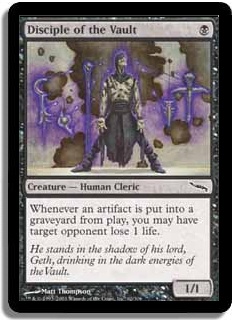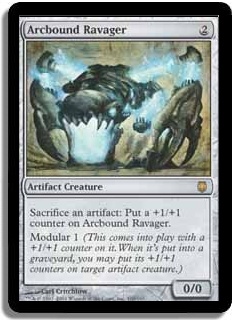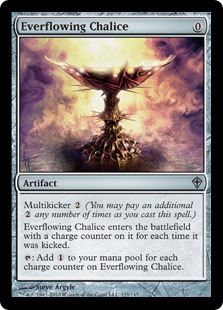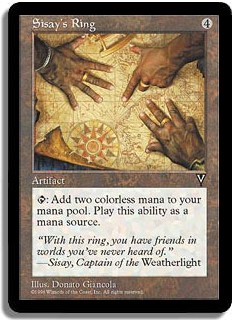It’s actually kind of amazing how much little changes in the card pool can radically alter the values of everything in the pool. One of my favorite examples of this has got to be this little guy:

Eventual Wisconsin State Champion, Adam Kugler, was playing Broodstar Affinity at States a long, long while back. Like a lot of people, he felt that it was really exciting and potent. But his real love was an Affinity deck with a bunch of crap in it. It played Ornithopter and Disciple of the Vault, and it always just seem to keep winning, even if it was by the skin of its teeth. He decided (though he may have been wrong) that this “Suicide” Affinity was just not good enough, and he went with something that just seemed more reliable.
And of course, in the next set, this was printed:

The world was changed forever. Ravager not only made a whole slew of cards really valuable, but it knocked out a veritable army of reasonable decks. Ironically, the head start that Kugler had had on the archetype was pretty much reduced to ash because Arcbound Ravager was so obviously powerful that the entire Magical Hive Mind more than made up for any gains he’d made in working on it — though Kugler would still become State Champ that year on the back of the Kiki-Jiki deck that I brewed up with Kowal and Dempsey.
New cards can open up possibility, or limit them. In a world with Time Walk, some cards simply aren’t playable; Vintage has more legal cards, by far, than any other format (says Mr. Obvious), but the smallest percentage of playables. It’s not just that some cards are unplayable, because there are unplayable cards in any format. More its that when you’re competing against the best of the best of the best, merely being good is not good enough to make the cut.
In less wild formats, other cards can also be delimiting for the same reason (if, perhaps, less strikingly). Flametongue Kavu single-handedly made it impossible to play most of the creatures in Standard, and Umezawa’s Jitte had a similar impact. Cryptic Command really hurts the incentives on playing whole classes of cards.

All of this is why I look to Everflowing Chalice as the Great Steel Hope from Worldwake. It’s not that Everflowing Chalice is crazily powerful in the same way that some of the splashier cards are, it’s that it opens up the possibilities of so, so many cards.
The biggest clear problem with Everflowing Chalice in Standard is the existence of Vampire Hexmage. Turning a Hexmage into a kind of Fulminator Mage is actually a fairly big deal. Typically, when you start turning to Stones or Signets, you build your deck with a manabase that is expecting that you’ll have access to them. Hexmage can easily take you away from getting the returns out of Chalice that you’ve built into your deck. Thankfully, nearly everyone I’ve talked to sounds like they’re planning on kicking Hexmage to the curb in favor of Kalastria Highborn and Ruthless Cullblade, in some combinations.
Everflowing Chalice has been called a crappy Mind Stone by many. Even if I believed this was true, I’d have to say that a crappy Mind Stone is just great when you don’t have a Mind Stone at all. Incinerate was “a crappy Lightning Bolt” for a very, very long time in most formats, but we weren’t super unhappy to play it, because it did the work we needed doing. Sure, we really could have used a hundred dollar bill in our pocket, but when we’re buying a sandwich from someplace simple, a twenty will do just fine.
Nearly everyone that is looking at the Chalice as a means to acquire four mana, and four mana alone is correct in thinking about Chalice as Mind Stone without useful abilities. This is a little off, though, like trying to compare Horizon Canopy to Saltcrusted Steppe — there are ways that Canopy is clearly just better, but if you’re making use of a card like Steppe (like Dreadship Reef, for example), sometimes there is no comparison.
Obviously that is a loose analogy, but perhaps things are best expressed concretely. Here is what you can expect to turn an Everflowing Chalice into, in terms of mana, from one turn to the next (depending on whether a land drop joins in or not):
2 becomes 4 (or 3)
3 becomes 5 (or 4)
4 becomes 7 (or 6)
5 becomes 8 (or 7)
6 becomes a lot (or a lot)

Essentially, what Everflowing Chalice does is open the way for the top end of the curve in a way we haven’t seen in a long time. I’m almost reminded of Urza’s Block’s impact on things in Standard after the many bannings had kicked in. What you have to remember is that Everflowing Chalice is not a Bad Mind Stone or a Sisay’s Ring or a Really Bad Gilded Lotus. Each of those cards wouldn’t be all that hot because of the constraints of each of them, either being too expensive to help early, or not potentially powerful enough to really shape what you can put into your deck. Everflowing Chalice, because of the way Multikicker works in it, isn’t a bad Mind Stone at all, but another card entirely, and a very good one.
Obviously, if we’re looking to the underplayed four mana cards, there are a whole slew of them. The most obvious of them is certainly our newest Wrath of God, Day of Judgment. But there are certainly a lot more than that, as well. If a deck can take the time to cast an Everflowing Chalice, there are cards we’ve been overlooking in Standard. While it’s true that Everflowing Chalice can help, somewhat, in making a Baneslayer Angel hit the table, Baneslayer was hitting the table before Everflowing Chalice hit the scene, and if Chalice wasn’t printed, it’d be doing the same thing.
Here are the ones to really pay attention to, that might be read for some time in the sun, finally:
Conqueror’s Pledge — This card is absolutely already seeing play. And it’s a great card long before Worldwake hit the scene. However, with Worldwake, not only is it going to be easier to simply cast the Pledge, but kicking it is something that is actually a real, reasonable possibility. Eleven mana is a lot of mana, and you don’t need to kick a Pledge for it to be good, but when kicking it is a real possibility, the card can be absurd.
Day of Judgment — This card hasn’t really been seeing any play, largely because by the time it comes to the party, it usually doesn’t matter any longer. Being able to cast this on turn 3 should change that, but also, being able to cast this on turn 8 and have a fair amount of extra mana to do something else with is definitely going to be meaningful. It still won’t make Day of Judgment good in the weaker matchups, but it will make it better, certainly.
Invincible Hymn — This one might be Pie-in-the-Sky, but this casual favorite might be a real option for an Everlasting Chalice-based control deck. Spending eight mana to go up to forty-plus life might actually be worth the time, if the mana makes it possible. It’s still likely not going to make the cut, but it’s worth keeping your mind open to the possibility as you brainstorm.
Iona, Shield of Emeria — This is one of the big ones, for me. Casting Iona before was usually something you’d see in the big, slow Emeria decks that would use other kinds of mana-ramping to try to get to it. These decks were by-and-large terrible. Everlasting Chalice is a reasonable way to “cheat” an Iona into play far sooner than we’ve seen in the past.
Open the Vaults — Particularly if we’re thinking about Time Sieve decks, Everlasting Chalice could spark a near-revolution, here. Even if Open the Vaults brings back Chalices as “useless,” they are still fodder for Time Sieves to eat. Even moments as simple as “Turn 4, cast a Chalice for two, cast a Howling Mine” seem particularly exciting. Keep your eyes on your Sieves!
World Queller — Being able to put a World Queller on line just a smidge sooner is a big deal to begin with. Beyond that, though, being able to profitably attack land with World Queller has a lot of potential power. With Chalice to keep your mana flowing, World Queller might be worth considering seriously.
Djinn of Wishes — One of the big things holding this card back has definitely been an inability to profitably activate its ability. By the time you might get to using the Djinn’s powers, the game might have already slid away. Now, you can cast him sooner, and activate him more often.
Ethersworn Adjudicator ¬— I’ve played this card in Block, and it is a real beating. The colorless requirements in activating his abilities are absolutely a real impediment, though. Any mana boost can make this creature far more potent.
Lorthos, the Tidemaker — I thought this card was cute when I saw it printed; just something that was so far out of reach, that its ability almost certainly didn’t matter. Now, though, it’s definitely something that I’d ponder. Activating Lorthos’s ability just seems like it usually reads, “I win.”
Master Transmuter ¬— In an artifact heavy deck, not only can you drop the Transmuter on turn 3, but when you reset the Chalice, you can also make it so that your real mana can match the mana cheating you’re doing with the Transmuter. A new archetype might live here.
Mind Spring — This card is a lot more reasonable from both sides. Not only is it easier to draw more cards, but it is also easier to use them.
Rite of Replication — I already liked this card before the new set. Certainly there are many decks against which Rite, like any other “anti”-critter card, is somewhat crappy. What is nice, though, is the ability to copy any threat potentially on turn three, and at a later point in the game, have a truly reasonable chance of just having a Rite of Replication be the equivalent of the nail in the coffin.
Sphinx of Jwar Isle — This card is obviously already good. But being able to cast it on turn 5 (or 4!) is a huge deal. Even without doing that, being able to cast it and hold a counterspell up all the sooner makes the Sphinx better than it ever was before.
Tezzeret the Seeker — Another card that was already good, but that just got a lot better. Using the Garruk ability on a big Everflowing Chalice is crazily unfair, and even if Tezzeret can’t create a multikicked Chalice, being able to search out Chalices without costing any loyalty is a good one too.
Time Warp — This easily fits into the natural space of Time Sieve or Turbo Fog, both of which get help by just having a solid mana-boost. Like Sphinx of Jwar Isle, this card was good before, but just being able to cast it with counters back, sooner, is huge.
Kalitas, Bloodchief of Ghet ¬— Visara saw play in Standard for a long while, just by being played fairly in monoblack control decks. Kalitas can easily serve the same function, given a potent mana boost.
Mind Shatter — While it doesn’t have the double-utility of Mind Spring, it does make casting a relevant hand destruction spell in a non-mono-black deck actually reasonable.
Ob Nixilis, the Fallen — For many people, Ob Nixilis is a de facto six drop. Dropping it into play on turn 5 with a double-pump from a fetchland seems absurd.
Sorin Markov¬ — Already seeing play (primarily as a sideboard card in Grixis-style decks), Sorin and Everflowing Chalice seem like an abundantly potent combination. Given the way that many of these other Black cards seem to be helped by Chalice, perhaps there is a new MBC deck to be made…
Banefire¬ — This card is one I’ve largely pooh-poohed for quite a long time. Chalice, though, actually makes me sit back and take notice of it again. It is all too reasonable to actually turn the Chalices themselves into a threat, as they prepare the way for an unpreventable, uncounterable Banefire of epic proportions.
Bogardan Hellkite ¬— I’ve already talked a little in the past about the possibility for a resurgence in Big Red or Ponza style decks. Bogardan Hellkite might be one of the paths for the deck, which, while it is unable to straight up kill a Baneslayer Angel, can often at least put a huge dent in the work an Angel does.
Chandra Ablaze — Like Sorin, Chandra Ablaze seems like it was practically made for this card. In either of it’s commonly used modes, Everflowing Chalice is of use, either because you have gotten a Chandra out soon enough that you have plenty of fodder to toss to it, or because you have enough mana that you’ve emptied you’re hand and you’re ready for a refill. I’m excited to see this card potentially take off.
Flameblast Dragon ¬— A Red Visara, of sorts, here is yet another possible finisher for a Big Red style deck.
Hellkite Charger — Here, we’re more looking at a Rorix, with the Chalice really threatening to make activating his ability very early a nearly a trivial question.
Lavaball Trap — Like Bogardan Hellkite, this is a lot of mana. It’s certainly no Wildfire (*sigh*), but it might be doable as both a hard-cast or as trapped, with a boost. I still have major doubts about its effect being powerful enough, but we’ll see.
Warp World — Everyone’s favorite, Warp World might not be excited to flip over a Chalice, but it doesn’t mind keeping its permanent count high. Casting incredibly quick Warp Worlds actually doesn’t seem out of reach even for a mono-red deck. This raises all kinds of interesting possibilities for a Big Red/Warp World hybrid.
Unbender Tine — The idea of Tine and Chalice as massive mana producers seems very exciting to me. It might not have a home, but it is compelling imagining the two working together to do absurd things.
Spellbound Dragon ¬— Using a Spellbound Dragon as both a faster threat, and a way to discard more expensive spells for great profit seems like a great combination to share a deck.
Ajani Vengeant — This fits right in the Day of Judgment category — a card that is already good on its own, but is all the more scary on turn 3 For some decks, sneaking this into play on turn 3 can make a game all but over.
Nicol Bolas, Planeswalker¬ — Combining three colors and Everflowing Chalice isn’t impossible, but it is certainly challenging. At the same time, it sounds downright evil to be able to cast Nicol on turns 6 or 7.
Realm Razer — Again, three colors might be harder to work, but being able to cast Realm Razer with a potent mana source on the table is truly unfair.
Platinum Angel — Pushing it into play before its time is passed is a good thing. But, like Sphinx of Jwar Isle, being able to drop it into play with protection all the sooner makes the Angel far more worth considering now than it has been in the past.
That’s a lot of cards. Many of them aren’t going to make it back into the fold of Cards We Care About. The thing about brainstorming, though, is trying to keep your mind open to what might be possible. When you’re building decks, it isn’t about trying to always have every at-bat be an attempt to hit the ball out of the park. Rather, it is more like taking some clods of dirt, and throwing it against the side of a wall. If you keep trying, perhaps something will stick.
Thirty-two cards worth more consideration might not sound like a lot, but it really is a huge amount. For many people, if you were to tell them there were maybe thirty-two cards in a small set potentially worth note, they’d likely be pretty excited. All of this value is coming out of one little card. If anyone was counting, you might have noticed that I didn’t have a single mono-Green card listed. Every possibility I considered seemed like it was either already being played in a way that Everflowing Chalice wouldn’t open up anew (usually because of Green’s pre-existing mana acceleration), or it just didn’t seem great. Gigantiform is no Conqueror’s Pledge, for example. Alas, alas…
I know I’m still in the brewing stage, and I haven’t even tested anything. In the meantime, I’ll probably just keep slogging along online with Red, at least until Worldwake pushes me into other things.
Until next week…
Adrian Sullivan

